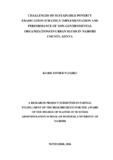| dc.description.abstract | Strategy implementation is a key element in organizational performance; good strategy implementation remains a major challenge. Execution of strategy entails operationalization of the strategy through establishment of structure and design, planning for resources and change management. This research focuses on challenges of sustainable poverty eradication strategy implementation and performance of NGO’s in urban slums in Nairobi County, Kenya. The study was anchored on resource based theory and open systems theory. The study employed a descriptive cross-sectional survey research design and the target population of this study consisted of all 53 NGO’s dealing with poverty eradication in Nairobi County, Primary data was obtained through administration of a semi- structured questionnaire. The questionnaires were administered via drop-pick-later method. They were sent out to the respective strategy development officer and project managers or equivalent of various NGO’s. Descriptive statistics was used to analyse the data. The quantitative results and multiple regression tests were both analyzed using SPSS version 22. The research concludes that there exists a strong positive relationship between organization communication process and strategy implementation process both which affected the performance of NGOs operating in urban slums in Nairobi County. The study also concluded that organization resources allocation would cause a positive change on strategy implementation process of non-governmental organizations in Nairobi County, Kenya. The study also concludes that strong organization culture promoted strategy implementation process which resulted to positive performance of NGOs operating in urban slums in Nairobi County. The study concludes that a unit increase in organizational structure cause a positive change on strategy implementation process of non-governmental organizations in Nairobi County, Kenya. The study further concludes that a firm resource capability has a crucial role in strategy implementation. NGOs need to further enhance their aggregate resources, especially physical and HR. The study also concludes that strong organization structure promoted strategy implementation process which resulted to positive performance of NGOs operating in urban slums in Nairobi County. The study recommends that the NGOs top managers must make communication plans and information channels to guarantee that stakeholders are kept informed and in contact with each other. NGOs HR department should encourage healthy teamwork among their employees. The human resource department should adopt key performance indicators in their operations and that it is vital for NGOs to have an efficient organizational structure. Several limitations were encountered in the course of research process. Some respondents were uncooperative in filling the questioners this was overcome by having a dialogue with the respondent’s, lack of enough finances, some respondents took a longer period of time to fill and complete the questionnaire. The study recommends that similar study should be carried to investigate the effect of core competences on performance of NGOs in Kenya or evaluate the effect of intellectual capital on performance on NGO’s in Kenya. | en_US |



